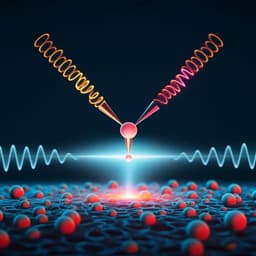
Physics
Quantum advantages for transportation tasks - projectiles, rockets and quantum backflow
D. Trillo, T. P. Le, et al.
This groundbreaking research by David Trillo, Thinh P. Le, and Miguel Navascués explores the quantum advantage in transportation tasks, revealing fascinating ultrafast and ultraslow quantum states that defy classical probabilities. Dive into the intriguing implications of their findings, including the extraordinary quantum advantage driven by the Bracken-Melloy constant.
~3 min • Beginner • English
Introduction
The study examines whether quantum mechanics confers operational advantages for transportation tasks—specifically, the probability that a freely evolving particle reaches a distant spatial region within a given time. While quantum effects like tunneling and quantum backflow are known, explicit transportation tasks showing a quantum advantage had not been formalized. The authors define projectile scenarios comparing a quantum particle with classical counterparts that share the same initial momentum distribution and spatial support (and later also the same position distribution), and ask whether quantum states can yield higher (ultrafast) or lower (ultraslow) arrival probabilities. They show such advantages exist, quantify them, and reveal that the maximal advantage is bounded by the Bracken-Melloy constant, thereby linking transportation advantages to quantum backflow. They further explore whether sequential ejection (rockets) can amplify the advantage and identify conditions where the backflow bound still applies. Finally, they propose a constrained comparison (fixing both position and momentum distributions) that permits significantly larger quantum advantages.
Literature Review
Prior works identified quantum backflow—negative probability flux at a point for states with positive momentum (Allcock; Bracken & Melloy)—and explored time-of-arrival operators and related phenomena. Numerical estimates suggested the Bracken-Melloy constant C_bm ≈ 0.0384517, but with no rigorous error bounds or strong upper bounds. Werner studied Wigner-function integration over wedges; Goussev and others connected backflow variants (constant forces, diffraction-in-time, reentry) and reported larger effects in modified settings. Experimental interest includes optical and BEC analogs of backflow. However, a concrete transportation task with rigorous quantum advantage bounds and explicit connection to backflow remained open, motivating this study.
Methodology
- Define a classical projectile: a mass M initially supported in [0,L], observed at time ΔT for arrival in [a,∞). The optimal classical arrival probability depends on the momentum threshold implied by initial position within [0,L].
- Define a quantum projectile: initial state ρ with position support in [0,L], free evolution under H = P^2/(2M), and arrival probability computed via the Born rule. Quantum advantage is the difference between the quantum arrival probability and the optimal classical one for the same momentum distribution.
- Reduce to a standard problem via metaplectic (and anti-metaplectic) transformations: show the advantage depends only on α := ML^2/ΔT, and map both ultrafast and ultraslow cases to a standard operator Ω = Θ(X+P) − Θ(P) optimized over states supported on (-√α,0].
- Existence of advantage: analyze the integral kernel representation of Ω restricted to S[-√α,0] to show φ(α) > 0 for all α > 0 (hence ultrafast and ultraslow states exist for any α).
- Numerical computation for finite α: approximate the analytic kernel by Taylor polynomials to obtain finite-dimensional operators Ω_N that can be diagonalized. Show φ(α) can be computed to precision δ by diagonalizing an N×N matrix with N = O(max(α, log(1/δ))). Derive a tight linear upper bound φ(α) < (2√3 − 3)α/(24π).
- Asymptotic analysis α → ∞: switch to the Wigner representation and reduce the optimization to integrating Wigner functions over wedges, leveraging Werner’s wedge-operator techniques. Incorporate constraints from support to refine bounds and obtain an upper bound for φ(∞).
- Variational lower bound: optimize linear combinations of expectation values of Ω and Θ(X) over truncated number-state subspaces to produce lower bounds on φ(∞). Visualize near-optimal Wigner functions.
- Equivalence to Bracken–Melloy constant: show via anti-metaplectic transformation that φ(∞) equals C_bm, the maximal backflow, establishing rigorous links between the projectile advantage and backflow.
- Connections to other effects: map various scenarios (generalized backflow, constant-force backflow, quantum reentry) to the (extended) standard problem via (anti-)metaplectic equivalences, unifying them under a single optimization framework.
- Quantum rocket model: define a minimal model where at discrete times the rocket of mass M(t) ejects fuel mass m_i via a CPTP splitting map Υ that acts internally and instantaneously, leaving the CM unchanged. Show such splitting maps factorize as Υ(ρ;σ,M,m) = U_{M−m}(ρ ⊗ σ)U_{M−m}^† with σ supported in the combustion chamber. Under this model (open chamber assumption), map the maximal quantum advantage to the standard problem and prove it is also bounded by C_bm.
- Enhanced transportation scenario: impose that the classical comparator must match not only the quantum momentum distribution but also the initial position distribution. Formulate the classical optimization as a linear program over non-negative phase-space distributions with fixed marginals; derive and solve its dual/ODE representation to compute the classical optimum p_C(ρ). Use operator inequalities Z = f(X)+g(P) satisfying a pointwise constraint to produce lower bounds on the quantum-classical gap W(ρ). Truncate Ω = Θ(X+P) − Θ(X) − Θ(P) in the number basis to obtain large finite matrices (up to N=1700) and extract eigenvalues as constructive lower bounds. Employ connections to Tsirelson-type operators to derive an analytic lower bound 0.1262.
- Numerical procedures: diagonalize truncated operators in Fock basis; compute Wigner-function integrals and wedge-operator spectra; solve ODEs for p_C; and use projected gradient heuristics (noting instability and non-differentiability issues near optima).
Key Findings
- Quantum projectile advantage exists for all α > 0: φ(α) > 0 (ultrafast and ultraslow states exist in any projectile scenario).
- Distance independence: The maximal quantum-classical arrival-probability gap depends only on α = ML^2/ΔT, not on the separation between preparation and target regions.
- Computational tractability: For finite α, φ(α) can be computed to precision δ by diagonalizing an N×N matrix with N ≤ max(α, log(1/δ)). Tight linear upper bound: φ(α) < (2√3 − 3)α/(24π).
- Asymptotic equivalence: lim_{α→∞} φ(α) equals the Bracken–Melloy constant C_bm (maximal quantum backflow).
- New rigorous bounds on C_bm: 0.0315 ≤ C_bm ≤ 0.0725 (supporting the long-standing conjecture C_bm ≈ 0.0384517).
- Quantum rockets (open combustion chamber, instantaneous internal splitting): the quantum advantage over classical rockets with matched momentum distributions and fuel constraints is also bounded by C_bm (no bootstrapping beyond backflow).
- Enhanced scenario (matching both initial position and momentum distributions): the quantum advantage can substantially exceed C_bm; numerical lower bounds reach 0.1228 (N=1700), and analytic arguments yield ≥ 0.1262.
- Unified view: Multiple known effects (standard/extended projectile problems, various forms of backflow, constant-force backflow, quantum reentry) are (anti-)metaplectically equivalent formulations of the same underlying optimization, illuminating their common structure.
Discussion
The results demonstrate concrete transportation tasks where quantum mechanics yields operational advantages compared to classical dynamics under matched initial data. The independence of the maximal gap from travel distance and its reduction to a single parameter α make the effect conceptually clean. By proving that this maximum equals the Bracken–Melloy constant and tightening its bounds, the work anchors transportation advantages to a well-known nonclassical phenomenon—quantum backflow—and clarifies their ultimate limitations in standard settings, including a broad class of quantum rockets. Equivalence mappings unify several seemingly disparate backflow-like effects, suggesting they are manifestations of a single mathematical structure under coordinate changes. Importantly, when the classical comparator is further constrained to match both position and momentum marginals, the quantum advantage increases markedly (≥0.1262), indicating that stronger operational gains are possible in practically relevant tasks that require classical systems to respect both distributions. These insights guide experimental design (projectile scenarios may be more accessible than backflow flux measurements) and motivate refined rocket models and constraints to explore larger quantum advantages.
Conclusion
The paper formalizes transportation tasks (projectiles and rockets) where quantum states can outperform classical counterparts in arrival probability within a fixed time. It shows the maximal advantage, for both ultrafast and ultraslow regimes, depends only on α = ML^2/ΔT and, in the asymptotic limit, equals the Bracken–Melloy constant. The authors provide rigorous bounds 0.0315 ≤ C_bm ≤ 0.0725, lending mathematical support to the conjectured value ≈0.0384517, and prove that a broad class of quantum rockets with instantaneous, internal, open-chamber fuel ejection are also limited by C_bm. By imposing that the classical comparator must share both initial position and momentum distributions with the quantum particle, they exhibit a substantially larger quantum advantage (at least 0.1262). Future work includes assessing rockets with one-sided closed combustion chambers, tightening bounds (both upper and lower) in constrained projectile scenarios, exploring experimental implementations, and extending beyond 1D nonrelativistic dynamics.
Limitations
- The rocket no-go result assumes instantaneous internal splitting with an open combustion chamber; alternative models (e.g., one-sided closed chamber, finite-time interactions) may evade the C_bm bound.
- Numerical estimates rely on truncated bases (up to N=1700) and may suffer from convergence and non-differentiability issues; upper bounds (e.g., 0.0725) may not be tight.
- Analysis is for 1D, nonrelativistic free evolution; external potentials, higher dimensions, and relativistic effects are not treated.
- Enhanced advantage (≥0.1262) is a lower bound; the exact optimum remains unknown, and gradient-based searches face instability.
- Experimental feasibility and robustness to noise/decoherence are not quantitatively analyzed.
Related Publications
Explore these studies to deepen your understanding of the subject.







